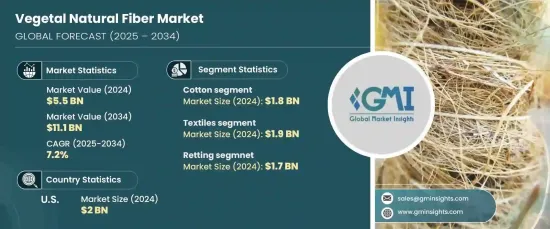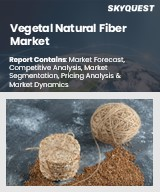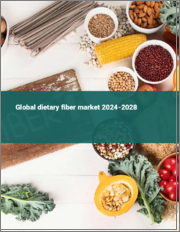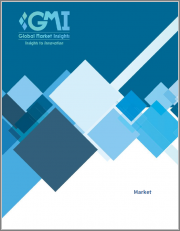
|
시장보고서
상품코드
1667156
세계의 식물성 천연섬유 시장 : 기회, 성장 촉진요인, 산업 동향 분석 및 예측(2025-2034년)Vegetal Natural Fiber Market Opportunity, Growth Drivers, Industry Trend Analysis, and Forecast 2025 - 2034 |
||||||
세계의 식물성 천연섬유 시장은 2024년 55억 달러였고, 2025년부터 2034년까지 CAGR 7.2%로 예측되고 있습니다.
면, 황마, 대마, 아마, 사이잘, 코코넛과 같은 식물 유래의 이러한 섬유는 합성 재료를 대체하는 환경 의식이 높은 대안을 제공합니다. 강도, 다목적 및 생분해성으로 알려진 이러한 섬유는 지속 가능한 관행의 도입을 목표로 하는 산업계에서 점점 더 요구되고 있습니다. 환경 의식이 높아짐에 따라 섬유 제품, 자동차 부품, 건축자재의 천연섬유에 대한 수요도 높아지고 있습니다. 소비자는 유기적 특성과 환경에 미치는 영향이 적기 때문에 천연섬유를 사용한 제품을 선호합니다. 이 추세는 다양한 응용 분야에서 친환경 솔루션과 지속 가능한 소재를 채택하는 방향으로의 광범위한 변화를 반영합니다.

면 부문은 2024년 18억 달러를 차지했으며 CAGR 7.2%로 성장할 것으로 예측됩니다. 황마, 대마, 아마, 사이잘, 코코넛과 같은 다른 식물성 섬유는 지속가능성과 기능성으로 시장에서 견인력을 증가시키고 있습니다. 황마와 대마 수요는 포장 및 건축과 같은 산업에서 증가하고 있으며, 아마는 가정용 가구에 사용됩니다. 사이잘과 코코넛 섬유도 산업 및 농업 응용 분야에서 유용성으로 인해 확대 경향이 있습니다.
| 시장 범위 | |
|---|---|
| 시작연도 | 2024년 |
| 예측연도 | 2025-2034년 |
| 시작금액 | 55억 달러 |
| 예측 금액 | 111억 달러 |
| CAGR | 7.2% |
용도별로는 섬유 부문이 2024년에 19억 달러를 차지해, 예측 기간을 통해 CAGR 6.3%로 확대할 것으로 예측되고 있습니다. 식물성 천연섬유는 독특한 특성으로 자동차에서 농업까지 다양한 산업에 통합되어 있습니다. 자동차 분야에서 이러한 섬유는 가볍고 지속 가능한 인테리어 부품에 기여합니다. 건설 용도에서도 친환경 복합재료를 위해 식물성 섬유가 채택되었습니다. 패키징 솔루션은 지속가능성에 대한 수요 증가에 대응하기 위해 식물성 섬유의 이용을 증가시키고 있으며, 농업용도에서는 토양 개선과 침식 방지가 이루어지고 있습니다.
원시 식물성 섬유를 사용 가능한 재료로 바꾸려면 가공 방법이 중요한 역할을 합니다. 2024년에 17억 달러로 평가됐고 CAGR 6.1%의 성장이 예상되는 일반적인 가공법인 레팅은 식물성 섬유를 물에 담가 목질 부분으로부터 분리합니다. 탈피 및 방적과 같은 다른 방법은 깨끗하고 고품질의 섬유를 생산하는 데 중요하며, 직물과 니트로 다양한 직물의 형태로 만듭니다.
미국의 식물성 천연섬유 시장은 2024년 20억 달러로 2034년까지 연평균 복합 성장률(CAGR) 6.5%로 성장할 것으로 예상됩니다. 이 성장의 원동력은 이 나라의 경제력, 혁신적인 산업 부문, 지속가능성과 소비자 동향에 대한 전략적 주력입니다. 호의적인 정책과 첨단 인프라가 미국을 북미 시장의 선두 주자로 삼고 있습니다.
목차
제1장 조사 방법과 조사 범위
- 시장 범위와 정의
- 기본 추정과 계산
- 예측 계산
- 데이터 소스
- 1차
- 2차
- 유료소스
- 공적소스
제2장 주요 요약
제3장 업계 인사이트
- 업계 생태계 분석
- 밸류체인에 영향을 주는 요인
- 이익률 분석
- 변혁
- 미래의 전망
- 제조업체
- 유통업체
- 공급자의 상황
- 이익률 분석
- 주요 뉴스
- 규제 상황
- 영향요인
- 성장 촉진요인
- 지속 가능한 재료에 대한 수요 증가
- 섬유 및 패션 산업의 확대
- 자동차 산업에의 채용
- 업계의 잠재적 리스크 및 과제
- 인식과 교육이 한정적
- 성장 촉진요인
- 성장 가능성 분석
- Porter's Five Forces 분석
- PESTEL 분석
제4장 경쟁 구도
- 소개
- 기업의 시장 점유율 분석
- 경쟁 포지셔닝 매트릭스
- 전략 전망 매트릭스
제5장 시장 추계 및 예측 : 제품별, 2021-2034년
- 주요 동향
- 면 섬유
- 황마 섬유
- 대마 섬유
- 아마 섬유(리넨)
- 사이잘 섬유
- 코코넛 섬유(코이어)
제6장 시장 추계 및 예측 : 용도별, 2021-2034년
- 주요 동향
- 섬유 산업
- 자동차 산업
- 건설재료
- 포장
- 농업 및 원예
- 지오텍스타일
제7장 시장 추계 및 예측 : 가공 방법별, 2021-2034년
- 주요 동향
- 레팅
- 박리
- 방적
- 직물 및 편물
- 복합재료 제조
제8장 시장 추계 및 예측 : 지역별, 2021-2034년
- 주요 동향
- 북미
- 미국
- 캐나다
- 유럽
- 영국
- 독일
- 프랑스
- 이탈리아
- 스페인
- 러시아
- 아시아태평양
- 중국
- 인도
- 일본
- 한국
- 호주
- 라틴아메리카
- 브라질
- 멕시코
- 중동 및 아프리카
- 남아프리카
- 사우디아라비아
- 아랍에미리트(UAE)
제9장 기업 프로파일
- Aditya Birla Group
- Antex
- Golden Peacock Group
- Kelheim Fibres
- Lenzing
- Nufarm
- Safilens
- Sateri Holdings
- Shandong Jilin Chemical Fiber
- Shandong Ruyi Textile Group
- Shanghai Chemical Industries
- Shenglong Group
- Suominen Oyj
- Thai Rayon PCL
- Zhejiang Huafu Chemical Fiber
The Global Vegetal Natural Fiber Market, valued at USD 5.5 billion in 2024, is projected to experience a CAGR of 7.2% from 2025 to 2034. These fibers, derived from plant sources such as cotton, jute, hemp, flax, sisal, and coconut, offer an eco-conscious alternative to synthetic materials. Known for their strength, versatility, and biodegradable nature, these fibers are increasingly sought after across industries aiming to adopt sustainable practices. As environmental awareness grows, so does the demand for natural fibers in textiles, automotive components, and building materials. Consumers are favoring products made with natural fibers due to their organic properties and minimal environmental impact. This trend reflects a broader shift toward adopting environmentally friendly solutions and sustainable materials in various applications.

The cotton segment accounted for USD 1.8 billion in 2024 and is forecasted to grow at a CAGR of 7.2%. Other vegetal fibers such as jute, hemp, flax, sisal, and coconut are gaining traction in markets driven by their sustainability and functionality. The demand for jute and hemp is increasing in industries like packaging and construction, while flax finds use in home furnishings. Sisal and coconut fibers are also witnessing expansion due to their utility in industrial and agricultural applications.
| Market Scope | |
|---|---|
| Start Year | 2024 |
| Forecast Year | 2025-2034 |
| Start Value | $5.5 Billion |
| Forecast Value | $11.1 Billion |
| CAGR | 7.2% |
In terms of application, the textiles sector held USD 1.9 billion in 2024 and is projected to expand at a CAGR of 6.3% through the forecast period. Vegetal natural fibers are being integrated into diverse industries, from automotive to agriculture, owing to their unique properties. In the automotive sector, these fibers contribute to lightweight and sustainable interior components. Construction applications are also embracing vegetal fibers for eco-friendly composite materials. Packaging solutions increasingly use these fibers to meet the growing demand for sustainability, while agricultural uses include soil conditioning and erosion control.
Processing methods play a significant role in transforming raw vegetal fibers into usable materials. Retting, a common process valued at USD 1.7 billion in 2024 and expected to grow at a CAGR of 6.1%, involves soaking plant fibers in water to separate them from woody parts. Other methods like decortication and spinning are critical in producing clean, high-quality fibers, which are then woven or knitted into various fabric forms.
The U.S. vegetal natural fiber market, valued at USD 2 billion in 2024, is expected to grow at a 6.5% CAGR through 2034. This growth is fueled by the country's economic strength, innovative industrial sector, and strategic focus on sustainability and consumer trends. Favorable policies and advanced infrastructure further position the U.S. as a leader in the North American market.
Table of Contents
Chapter 1 Methodology & Scope
- 1.1 Market scope & definitions
- 1.2 Base estimates & calculations
- 1.3 Forecast calculations
- 1.4 Data sources
- 1.4.1 Primary
- 1.4.2 Secondary
- 1.4.2.1 Paid sources
- 1.4.2.2 Public sources
Chapter 2 Executive Summary
- 2.1 Industry synopsis, 2021-2034
Chapter 3 Industry Insights
- 3.1 Industry ecosystem analysis
- 3.1.1 Factor affecting the value chain
- 3.1.2 Profit margin analysis
- 3.1.3 Disruptions
- 3.1.4 Future outlook
- 3.1.5 Manufacturers
- 3.1.6 Distributors
- 3.2 Supplier landscape
- 3.3 Profit margin analysis
- 3.4 Key news & initiatives
- 3.5 Regulatory landscape
- 3.6 Impact forces
- 3.6.1 Growth drivers
- 3.6.1.1 Increasing demand for sustainable materials
- 3.6.1.2 Expanding textile and fashion industry
- 3.6.1.3 Automotive industry adoption
- 3.6.2 Industry pitfalls & challenges
- 3.6.2.1 Limited awareness and education
- 3.6.1 Growth drivers
- 3.7 Growth potential analysis
- 3.8 Porter’s analysis
- 3.9 PESTEL analysis
Chapter 4 Competitive Landscape, 2024
- 4.1 Introduction
- 4.2 Company market share analysis
- 4.3 Competitive positioning matrix
- 4.4 Strategic outlook matrix
Chapter 5 Market Estimates & Forecast, By Product, 2021-2034 (USD Million) (Tons)
- 5.1 Key trends
- 5.2 Cotton fibers
- 5.3 Jute fibers
- 5.4 Hemp fibers
- 5.5 Flax fibers (linens)
- 5.6 Sisal fibers
- 5.7 Coconut fibers (coir)
Chapter 6 Market Estimates & Forecast, By Application, 2021-2034 (USD Million) (Tons)
- 6.1 Key trends
- 6.2 Textiles
- 6.3 Automotive industry
- 6.4 Construction materials
- 6.5 Packaging
- 6.6 Agricultural and horticultural applications
- 6.7 Geotextiles
Chapter 7 Market Estimates & Forecast, By Processing Methods, 2021-2034 (USD Million) (Tons)
- 7.1 Key trends
- 7.2 Retting
- 7.3 Decortication
- 7.4 Spinning
- 7.5 Weaving and knitting
- 7.6 Composite manufacturing
Chapter 8 Market Estimates & Forecast, By Region, 2021-2034 (USD Million) (Tons)
- 8.1 Key trends
- 8.2 North America
- 8.2.1 U.S.
- 8.2.2 Canada
- 8.3 Europe
- 8.3.1 UK
- 8.3.2 Germany
- 8.3.3 France
- 8.3.4 Italy
- 8.3.5 Spain
- 8.3.6 Russia
- 8.4 Asia Pacific
- 8.4.1 China
- 8.4.2 India
- 8.4.3 Japan
- 8.4.4 South Korea
- 8.4.5 Australia
- 8.5 Latin America
- 8.5.1 Brazil
- 8.5.2 Mexico
- 8.6 MEA
- 8.6.1 South Africa
- 8.6.2 Saudi Arabia
- 8.6.3 UAE
Chapter 9 Company Profiles
- 9.1 Aditya Birla Group
- 9.2 Antex
- 9.3 Golden Peacock Group
- 9.4 Kelheim Fibres
- 9.5 Lenzing
- 9.6 Nufarm
- 9.7 Safilens
- 9.8 Sateri Holdings
- 9.9 Shandong Jilin Chemical Fiber
- 9.10 Shandong Ruyi Textile Group
- 9.11 Shanghai Chemical Industries
- 9.12 Shenglong Group
- 9.13 Suominen Oyj
- 9.14 Thai Rayon PCL
- 9.15 Zhejiang Huafu Chemical Fiber
















